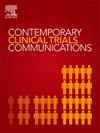Participant recruitment and retention in randomised controlled trials of melanoma surveillance: A scoping review
IF 1.4
Q4 MEDICINE, RESEARCH & EXPERIMENTAL
引用次数: 0
Abstract
Background
This scoping review aims to collate and describe data on recruitment, retention, and strategies used to improve these, in randomised controlled trials of melanoma surveillance.
Methods
We searched MEDLINE, EMBASE, CINAHL and CENTRAL databases from inception until October 23, 2023. Two reviewers screened titles and abstracts, and full-texts, and one reviewer extracted data (convenience sample (n = 5) checked by a second). Eligibility criteria included: (i) RCT design, (ii) clinical setting, (iii) participants at increased risk of melanoma, (iv) interventions for early melanoma detection, and (v) early detection outcomes or surrogates such as improved skin self-examination. We calculated summary statistics and undertook qualitative data synthesis.
Results
From 1746 records, 21 trials (reported in 28 papers) were included. Recruitment sources included dermatology clinics, general practice sites, and hospital databases or registries. Trials reported proportions of those screened who were eligible (mean 75 %, range 24–100 %), proportions of those eligible who were randomised (mean 63 %, range 24–95 %), numbers randomised per month (mean 25 participants, range 2–74), and proportion of those randomised who completed outcome measurements (mean 85 %, range 59–100 %) for self-report questionnaires at primary timepoints). Recruitment strategies included targeted participant identification and flexible consent processes. Retention strategies included setting narrow eligibility criteria, reminders, and financial incentives. Reporting on strategies was limited and there were no reports on effectiveness. Few studies reported recruiter facing initiatives or public and patient involvement.
Discussion
More consistent and detailed reporting of recruitment and retention strategies in RCTs is needed, alongside evaluations of their effectiveness.
黑素瘤监测随机对照试验的参与者招募和保留:范围综述
背景:本综述旨在整理和描述黑色素瘤监测随机对照试验中招募、保留和改善策略的数据。方法检索MEDLINE、EMBASE、CINAHL、CENTRAL等数据库至2023年10月23日。两名审稿人筛选标题、摘要和全文,一名审稿人提取数据(方便样本(n = 5)由另一名审稿人检查)。入选标准包括:(i)随机对照试验设计,(ii)临床环境,(iii)黑色素瘤风险增加的参与者,(iv)早期黑色素瘤检测的干预措施,以及(v)早期检测结果或替代指标,如改善皮肤自检。我们进行了汇总统计,并进行了定性数据综合。结果共纳入1746例临床试验21例(文献28篇)。招募来源包括皮肤科诊所、全科诊所和医院数据库或登记处。试验报告了筛选者的合格比例(平均75%,范围24 - 100%),随机分组的合格比例(平均63%,范围24 - 95%),每月随机分组的人数(平均25名参与者,范围2-74),以及在主要时间点完成自我报告问卷结果测量的随机分组比例(平均85%,范围59 - 100%)。招聘策略包括有针对性的参与者识别和灵活的同意程序。保留策略包括设定狭窄的资格标准、提醒和财务激励。关于战略的报告有限,没有关于有效性的报告。很少有研究报告招聘人员面临的倡议或公众和患者的参与。除了评估其有效性外,还需要对随机对照试验中的招聘和保留策略进行更一致和详细的报告。
本文章由计算机程序翻译,如有差异,请以英文原文为准。
求助全文
约1分钟内获得全文
求助全文
来源期刊

Contemporary Clinical Trials Communications
Pharmacology, Toxicology and Pharmaceutics-Pharmacology
CiteScore
2.70
自引率
6.70%
发文量
146
审稿时长
20 weeks
期刊介绍:
Contemporary Clinical Trials Communications is an international peer reviewed open access journal that publishes articles pertaining to all aspects of clinical trials, including, but not limited to, design, conduct, analysis, regulation and ethics. Manuscripts submitted should appeal to a readership drawn from a wide range of disciplines including medicine, life science, pharmaceutical science, biostatistics, epidemiology, computer science, management science, behavioral science, and bioethics. Contemporary Clinical Trials Communications is unique in that it is outside the confines of disease specifications, and it strives to increase the transparency of medical research and reduce publication bias by publishing scientifically valid original research findings irrespective of their perceived importance, significance or impact. Both randomized and non-randomized trials are within the scope of the Journal. Some common topics include trial design rationale and methods, operational methodologies and challenges, and positive and negative trial results. In addition to original research, the Journal also welcomes other types of communications including, but are not limited to, methodology reviews, perspectives and discussions. Through timely dissemination of advances in clinical trials, the goal of Contemporary Clinical Trials Communications is to serve as a platform to enhance the communication and collaboration within the global clinical trials community that ultimately advances this field of research for the benefit of patients.
 求助内容:
求助内容: 应助结果提醒方式:
应助结果提醒方式:


